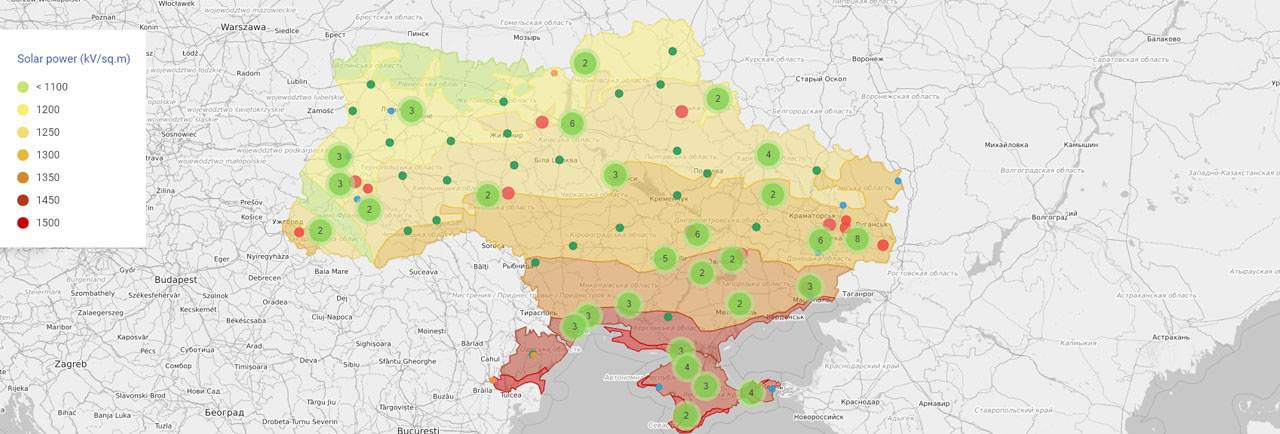The installed solar capacity in Ukraine is growing very quickly, passing 5GW in early 2020. This is an increase of more than 4GW since the start of 2018. The recent growth has been driven by reductions in PV technology costs, and also by a generous local feed-in tariff scheme.

Solar radiation resource in Ukraine
The available solar resource in Ukraine is significant, and is particularly strong in southern Ukraine. In the southern regions, annual solar irradiation is more than 1500 kWh per square meter. However, on a day to day basis, Ukraine experiences a wide range of cloud systems. These are commonly driven by low-pressure systems, which are particularly intense during the winter periods.
An excellent example of how weather systems can drive day to day variability occurred in the last week of February as a strong weather system brought scattered rain and snow over the region.

Weather systems such as this one result in strong variability in the available solar radiation across the day. This means that solar plant power output is impacted, with strong changes in energy generation across the day. As Ukraine adds more solar energy to its electricity grid, it is becoming important to predict these changes in energy generation from hours to days ahead.
These predictions of the changes in energy generation from hours to days ahead of time is called solar forecasting. This type of technology is essential for successful grid integration of increasing amounts of renewable energy. Accurate forecasts can help with day-ahead bidding of power, by allowing larger bids and/or reducing imbalance or accuracy penalties. Accurate solar forecasts are also helpful intra-day, for forecast revisions or re-bids by solar asset operators, and for system operators for balancing purposes including the minimization of plant curtailments.
Solar forecasting methods best suited for Ukraine
As has previously been discussed on this blog, there are several categories of technology which can produce solar forecasts for Ukrainian solar power plants. Using a combination of these technologies. It is possible to produce either a power forecast or a solar irradiance forecast.
Solar irradiance forecasting is focussed on the modeling of solar radiation directly, usually focusing on the conversion of satellite images to radiation estimates. A solar power plant operator can then use these forecasts to create their own energy forecasts using PV power models. This approach can be successful, but requires strong internal capabilities, since the conversions from radiation to power are highly non-linear and the plant and weather condition impacts are numerous.
Solar power forecasting services use PV plant specifications to create an energy prediction directly. These will most often use the solar irradiance forecasts, along with PV power plant measurements with a PV power modeling software to deliver solar energy generation estimates directly to the solar farm owner or operator.
One of the modern forecasting and monitoring solar radiation services is Solcast providing data for plan, construct, operate, and manage solar power systems across the world.
Guys approach solar modeling and forecasting as meteorologists working with the electricity sector, offer the following products:
- Solar Radiation Data — real-time and forecast solar radiation data, worldwide via API;
- Utility Scale — rapid update, more granular solar power and solar radiation forecasts for utility scale sites;
- Rooftop PV Forecasts — power forecasts for rooftop solar installations using the latest satellite data, worldwide;
- Grid Aggregations — solar visibility for markets and networks, load forecasting, manage network;
- Historical and TMY — proven and accurate historical satellite and aerosol data globally for applying their improved technology to produce the most accurate, lowest uncertainty historical irradiance estimates;
- Utility Scale Wind Forecasts — highly accurate wind power forecasts with global coverage, forecasts at 15 or 30 minute time granularity, out to +7 days ahead.
Solcast already provided to over 5,500 users with assessment and forecasting data for irradiance and PV power globally. Data create using satellites, validate with surface measurements, and extensively validate on all continents except Antarctica.
The future of solar forecasting in Ukraine
In Ukraine, new regulation is increasing the requirement for solar power forecasting, particularly day-ahead forecasting. The most important attributes for successful and accurate solar power forecasting in Ukraine are:
- use of a range of different weather models, to capture the different possibilities day ahead;
- machine-learning improvement of weather models to learn their systematic cloud and radiation errors;
- accurate power modeling based on plant specifications and use of production data during recent months or years.
Renewable energy in Ukraine today lacks services for the operational monitoring of local weather conditions and forecasting the level of solar radiation on-line. The only method used today is the persistent method, based on the analysis of statistical data collected over several years of power generation and taking into account the data of the current generation. Which was quite good in assessing annual generation, but in a changing climate, the accuracy of the persistent method fell significantly.
Our country has yet to create a system of automated processing and transmission of data on weather conditions and projected power generation. Also, an integral stage of successful market development is the adoption of the rules coordinating generation and the development of a mechanism for predicting the energy consumption by local networks. And much more.
***
For more than 10 years, AVENSTON has been introducing solar power plants to the commercial operation phase. We have gained extensive experience in the design, construction, and maintenance of solar power-stations in Ukraine and the world. Our design department carefully studies the details of each project, taking into account all the tasks set by the client. On our website, you can familiarize yourself with the portfolio of completed projects and read in detail about the services that Avenston provides.